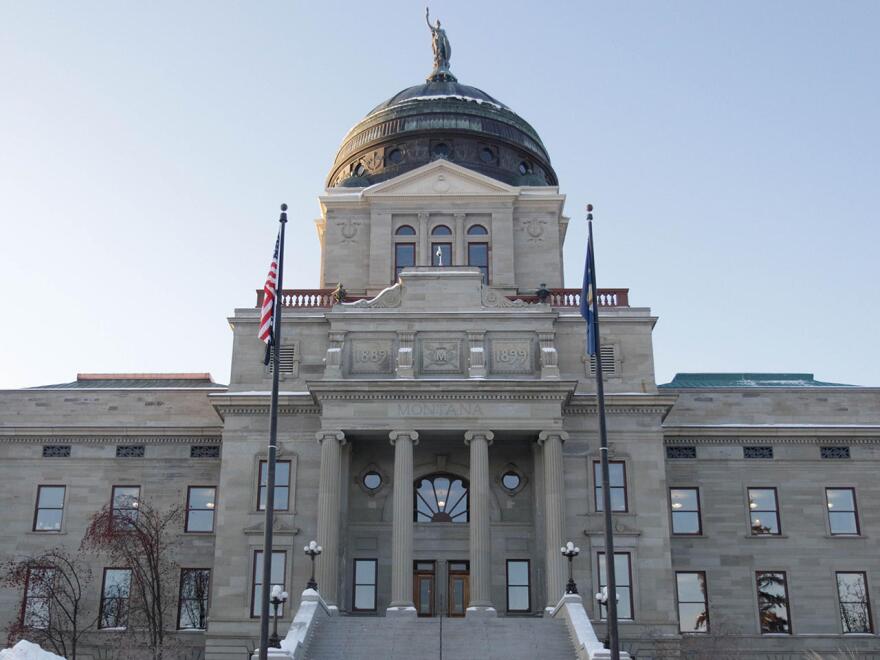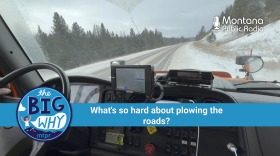Austin Amestoy: Welcome to The Big Why, a series from Montana Public Radio where we find out what we can discover together. I'm your host, Austin Amestoy. This is a show about listener-powered reporting. We'll answer questions, big or small, about anything under the Big Sky. By Montanans, for Montana, this is The Big Why.
In this special episode of The Big Why, we are doing things a little differently. Our listeners submit more questions than you'll hear answered on the show and there are a couple reasons for that. For one, we just don't have time to answer absolutely everything. And also, some have answers that don't quite fill up the full nine minutes for our episodes. But some of your questions are just so good, it would be a shame to let them pass us by. So, helping me out today is the host of another podcast airing on MTPR, Justin Angle of A New Angle. Justin, thanks for being here.
Justin Angle: Yeah, excited to get involved.
Austin Amestoy: Well, we like to keep things pretty simple on this show. We've picked three questions to answer in a Big Why speed round, if you will. You'll hear two of them now, and you can catch the third question as part of my interview with Justin on A New Angle. The two topics we're tackling for this version of the show are meteorology and metalworking.
Let's start with that first question. It comes to us from a listener in southwest Montana. Matt Mason lives in Gardiner, just north of Yellowstone National Park during the summer and loves to skateboard. The nearest skate park is in Livingston, which Mason noticed is prone to a weather phenomenon that can make his hobby a bit of a challenge.
Matt Mason: There's nothing more embarrassing than driving an hour to get to it to skate and it is so windy that I can't even ride my skateboard.
Justin Angle: I can't even imagine riding a skateboard myself, let alone trying to do it in the wind that Livingston regularly gets.
Austin Amestoy: Right, me neither, Justin. Matt Mason wanted to know, why is Livingston so windy?
Justin Angle: And maybe there's an underlying assumption to challenge here. Is it that Livingston is that windy, or Montana in general?
Austin Amestoy: I had the same thought, so I called up Tom Humphrey. He's the head meteorologist at the National Weather Service office in Billings. Humphrey says Livingston really is measurably windier than the rest of the state.
Justin Angle: Okay, so then what's so special about Livingston when it comes to the wind?
Austin Amestoy: Well, Humphrey says there are a few phenomena at play.
Tom Humphrey: Okay. The basic one that produces the strongest winds at Livingston typically happen in the fall and winter time.
Austin Amestoy: During that time, Humphrey says high pressure systems over Yellowstone National Park, south of Livingston, and low pressure systems moving down from Canada often create what's called a pressure gradient. Basically, when those two systems collide, air from that high pressure system gets pushed into that low pressure area.
Justin Angle: So all that high pressure from Yellowstone funnels up through the Paradise Valley into Livingston?
Austin Amestoy: And produces some gusty winds, Justin. In fact, the Livingston Enterprise reported a 92 mile per hour gust in late February this year. That was just two miles per hour short of the city's all time record.
Justin Angle: I can't even imagine 92 miles an hour.
Austin Amestoy: Yeah, I feel like I'd have a hard time standing up in that.
Justin Angle: Let alone skateboarding.
Austin Amestoy: That's right. But there's also one more phenomenon at play. Gap winds. Justin, have you ever put your thumb over the top of a garden hose?
Justin Angle: Yes, often I seem to break a hose nozzle all the time, so I'm familiar with the finger of the tip of the hose work around.
Austin Amestoy: Well, let's hear from Humphrey again.
Tom Humphrey: The smaller you make that opening, the faster the water is going to squirt out of there. And that's the same thing for Livingston.
Austin Amestoy: Paradise Valley sits between two mountain ranges. So, you can think of that narrow valley like a thumb closing off the winds, rushing up from Yellowstone. As the winds move along that pressure gradient, the gap in the mountains forces them to accelerate.
Justin Angle: Right, so we have an air pressure gradient plus gap winds, and we get Montana's windiest city.
Austin Amestoy: That's the equation, Justin. Shall we move on to our next question?
Justin Angle: Yeah, let's do it.
Austin Amestoy: All right. Our second Big Why question today takes us to Helena. That's where listener Sarah Bond has lived for about four decades. She worked for the state government and spent a lot of time soaking-in the Capitol building's ornate details.
Sarah Bond: Throughout that time, I often ask many people, who in the heck is on top of that dome?
Justin Angle: So is she talking about the statue on top of the Capitol building?
Austin Amestoy: That's right. It's as old as the Capitol itself, dating back to the early 1900s. And at first glance, it feels really familiar. A woman wearing Romanesque robes, holding a torch high above her head and a wreath in her other hand, and a starred and striped shield resting against her body.

Justin Angle: Yeah, it sounds a little like another statue out east that's quite a bit bigger.
Austin Amestoy: That's right, and former Montana Historical Society curator Kirby Lambert says the organization shared the same opinion.
Kirby Lambert: We classified the statue as a personification of liberty.
Austin Amestoy: Lambert says the statue's history was totally unknown for more than 100 years. The documents that would have identified its creator were destroyed in a fire. So, the best the historical society could do was guess. She looked like liberty, so she became known as Liberty. And that name stuck for nearly a century. All of that changed, though, in 2006, when Lambert's phone rang.
Kirby Lambert: Picked up the phone, just not having any idea what it might be in. This woman on the other end said, I'm calling to find out if my grandfather's statue is still on your state Capitol.
Justin Angle: Really? So call came out of the blue completely?
Austin Amestoy: That's right.
Justin Angle: Okay, so who was on the other end?
Austin Amestoy: That would be Alice Nagle of Hatfield, Pennsylvania. Nagle had recently discovered a trunk that had belonged to her late grandfather, Edward Van Landeghem. He was a Belgian born metal sculptor who worked in Pennsylvania after immigrating. When Nagle opened the trunk, she found several newspaper clippings with an image of one of her grandfather's statues. And that statue, it was the one on top of the Capitol. But the thing is ...
Alice Nagle: All the article that I had on it was she was called 'Montana.'
Justin Angle: So Liberty is actually Montana?
Austin Amestoy: Exactly. Nagle says she was immediately intrigued, and she wanted to set the record straight.
Alice Nagle: And that's when I started searching for somebody to correspond with, and I picked Kirby's name and I picked the right one.
Austin Amestoy: Lambert says the historical society quickly redesignated Liberty as Montana, and though she may resemble her sister in New York Harbor, Lambert says that choice is likely very intentional.
Kirby Lambert: So, I think it's kind of a combination of being proud to be Montanans, but also an attempt to say, hey, we belong, we're legitimate.
Austin Amestoy: And that's the origin of the Capitol dome statue. Two questions in one episode. Not too bad, right, Justin?
Justin Angle: Not bad at all. And if you Big Why listeners want to catch a third bonus question, we've got it over on my show, A New Angle. Austin and I will also take a look behind the curtain of The Big Why and I'll ask him a few questions about how it all works.
Austin Amestoy: That's right Justin, a special Big Why crossover episode of A New Angle is available right now at anewanglepodcast.com, or wherever you get your podcasts.
Now we want to know what makes you curious about Montana. Submit your questions below. Find us wherever you listen to podcasts and help others find the show by sharing it and leaving a review. Let's see what we can discover together!
-
When it comes to winter driving, everyone wants their route clear and dry, and they want it done quickly. Why don't the plows come sooner or more often? Why don't they drop more salt or deicer? Why not get more drivers on the road? Tag along as a Montana snowplow driver prepares for a big winter storm and find out more about the logistical, environmental and technical challenges that come with keeping the roads clear of snow.
-
How do cabbage and spices become ingredients for community building? In Korea, the answer is kimjang, the fall tradition of making and sharing kimchi. This week on The Big Why, we visit a farm in the Bitterroot Valley where a group of Montanans came together to keep a food custom alive and find comfort and connection among the cabbage.
-
In Montana, abortion access has been at times illegal, legal, and stuck in limbo. Providers have weathered bombings and arson, advocates and opponents have battled it out in court, and citizens have passed a constitutional amendment affirming a woman's right to choose. One listener wants to know more about the history of reproductive rights in Montana. MTPR's Aaron Bolton reports on the underground networks, political violence and landmark court cases that got us to where we are today.
-
A flag's primary purpose is to be recognized from a distance. That means few colors, no lettering and a clear distinction from other flags. Ideally, it should be simple enough for a child to draw it from memory. So, how did Montana end up with such a complicated flag? Learn more in this episode of The Big Why.
-
Everywhere you look in Montana, there are places to gamble. Odds are good you've seen machines in bars, liquor stores and of course, gas stations. How did Montana end up with so many "casinos," and what does it have to do with bingo? The only sure bet is that The Big Why team has the answers.
-
This week on The Big Why, we’re exploring Montana’s 56 counties. A listener from Billings wants to know how they got their shapes. Finding the answer led MTPR's Austin Amestoy down a rabbit hole where he found a saga of boom and bust, backroom dealing and an unlikely folk hero.










